Student and Teacher Projects
2016 Projects
Students and teachers in the 2016 Joint Science and Technology Institute took part in research projects in a variety of scientific disciplines.
High School Student Projects
- Microbes and Bacteria Resistant Surfaces
- Synthetic Biology
- Environmental Water Quality
- Military Packaging
- Mathematics and Modeling Mania
- Robotics
- Raspberry Pi
- Motorized Droplet Actuation System (Exploring Engineering through Hopping the Droplets)
- 3D Printing
- Plugging into the Internet of Things
Microbes and Bacteria Resistant Surfaces
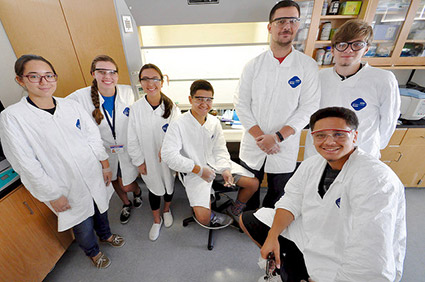 Microbes are prolific in the natural environments and are encountered in daily life constantly. A better understanding of how these microbes interact with each other, surfaces, and humans could lead to better control of disease spread from surfaces. Students will be exposed to standard microbiological techniques, including media preparation, bacterial growth and characterization, and DNA extraction and sequencing. Additionally students will be exposed to creation and characterization of anti-microbial materials through simple organic synthesis procedures.
Microbes are prolific in the natural environments and are encountered in daily life constantly. A better understanding of how these microbes interact with each other, surfaces, and humans could lead to better control of disease spread from surfaces. Students will be exposed to standard microbiological techniques, including media preparation, bacterial growth and characterization, and DNA extraction and sequencing. Additionally students will be exposed to creation and characterization of anti-microbial materials through simple organic synthesis procedures.
Synthetic Biology
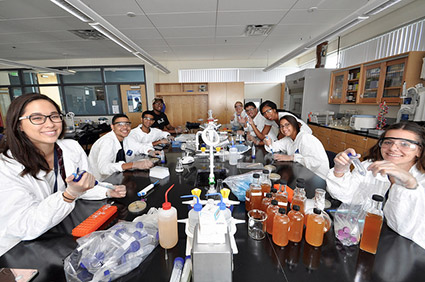 Synthetic biology is an emerging scientific discipline that combines science and engineering in order to design and build novel biological functions and systems. This includes the design and construction of new biological parts, devices, and systems (e.g., tumor-seeking microbes for cancer treatment), as well as the re-design of existing, natural biological systems for useful purposes (e.g., photosynthetic systems to produce energy). Students will grow bacteria, manipulate DNA, create genetic devices, and take bacterial photographs while exploring the challenges, risks, and rewards of synthetic biology.
Synthetic biology is an emerging scientific discipline that combines science and engineering in order to design and build novel biological functions and systems. This includes the design and construction of new biological parts, devices, and systems (e.g., tumor-seeking microbes for cancer treatment), as well as the re-design of existing, natural biological systems for useful purposes (e.g., photosynthetic systems to produce energy). Students will grow bacteria, manipulate DNA, create genetic devices, and take bacterial photographs while exploring the challenges, risks, and rewards of synthetic biology.
Environmental Water Quality
 The Chesapeake Bay watershed includes the states of Pennsylvania, Maryland, Delaware and Virginia as well as the District of Columbia. Runoff from land, storm water, and wastewater treatment effluent contribute to the water in the stream and rivers which flow into the bay. Different chemicals impact the health of the bay and are monitored by the EPA and other organizations. Too much of any chemical can have a negative effect on the bay, causing the depletion of oxygen and the death of the fish and other organisms in the bay. Students will collect water samples from several locations in the Chesapeake Watershed and analyze them for nitrate, ammonia, phosphate, and bacteria. Based on the measurements, students will be able to piece together how human activity can impact the Bay’s ecosystem.
The Chesapeake Bay watershed includes the states of Pennsylvania, Maryland, Delaware and Virginia as well as the District of Columbia. Runoff from land, storm water, and wastewater treatment effluent contribute to the water in the stream and rivers which flow into the bay. Different chemicals impact the health of the bay and are monitored by the EPA and other organizations. Too much of any chemical can have a negative effect on the bay, causing the depletion of oxygen and the death of the fish and other organisms in the bay. Students will collect water samples from several locations in the Chesapeake Watershed and analyze them for nitrate, ammonia, phosphate, and bacteria. Based on the measurements, students will be able to piece together how human activity can impact the Bay’s ecosystem.
Military Packaging
Students and teachers will learn about military packaging and the importance of developing good packaging design. They will be exposed to some packaging materials, design concepts, packaging requirements and the environmental factors during transit, handling and storage. They will also be involved in hands-on activities, including developing and designing a package for an item that they are given and watching their design go through testing to determine pass or fail. Some things or requirements may tweak but basically the intent is for students to be creative and innovative in developing some designs. These design principles may impact the commercial world of proposed drone delivery services.
Mathematics and Modeling Mania
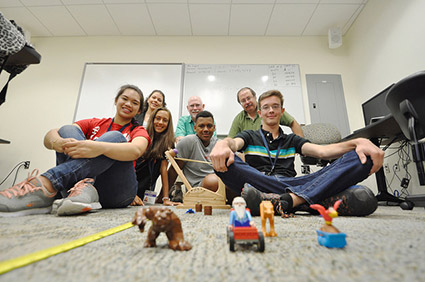 For this project, students will be introduced to the statistics and math modeling used by Operations Research (OR) analysts for a variety of tasks. Starting with the basics of probability, statistics and the modeling of a physical system, we will then move into some hands-on experiments with catapults. This provides a physical setting for students to apply statistics and design of experiments—important components in generating and analyzing data for model development. The remainder of the first week will be spent on some toxicology modeling, and a simplified model for disease propagation as a simulation to demonstrate how various pathogen parameters and countermeasures impact the worldwide spread of a contagion. Students will be given a primer on how several real-world diseases behave and then given the option to enhance their pathogen of choice to more fully infect the world in the simulation. The second phase of this project will introduce the math and science behind coordinate systems, navigation (including GPS), meteorology, and simplified atmospheric transport and dispersion of pollutants/hazards. Student will use the Hazard Prediction and Assessment Capability (HPAC) simulation from the Defense Threat Reduction Agency (DTRA) to examine what might happen from various kinds of chemical, biological, radiological, and nuclear (CBRN) releases at locations near and dear to the students. Rounding out their experience will be introductions to various methods for individual protection from CBRN hazards, computing hardware, binary math, and a tour of a high performance computing center.
For this project, students will be introduced to the statistics and math modeling used by Operations Research (OR) analysts for a variety of tasks. Starting with the basics of probability, statistics and the modeling of a physical system, we will then move into some hands-on experiments with catapults. This provides a physical setting for students to apply statistics and design of experiments—important components in generating and analyzing data for model development. The remainder of the first week will be spent on some toxicology modeling, and a simplified model for disease propagation as a simulation to demonstrate how various pathogen parameters and countermeasures impact the worldwide spread of a contagion. Students will be given a primer on how several real-world diseases behave and then given the option to enhance their pathogen of choice to more fully infect the world in the simulation. The second phase of this project will introduce the math and science behind coordinate systems, navigation (including GPS), meteorology, and simplified atmospheric transport and dispersion of pollutants/hazards. Student will use the Hazard Prediction and Assessment Capability (HPAC) simulation from the Defense Threat Reduction Agency (DTRA) to examine what might happen from various kinds of chemical, biological, radiological, and nuclear (CBRN) releases at locations near and dear to the students. Rounding out their experience will be introductions to various methods for individual protection from CBRN hazards, computing hardware, binary math, and a tour of a high performance computing center.
Robotics
 The field of robotics is growing by leaps and bounds: from movie props to performing delicate surgeries. As an introduction to robotics, students will explore the gambit of emerging trends and future applications in the industry including traditional uses like welding and high speed sortation through to drones and humanoids. Students will then get hands on by designing, building, and programming robots to to score points in a competition. The basic engineering principles from mechanical design and assembly to algorithms and coding will also be introduced.
The field of robotics is growing by leaps and bounds: from movie props to performing delicate surgeries. As an introduction to robotics, students will explore the gambit of emerging trends and future applications in the industry including traditional uses like welding and high speed sortation through to drones and humanoids. Students will then get hands on by designing, building, and programming robots to to score points in a competition. The basic engineering principles from mechanical design and assembly to algorithms and coding will also be introduced.
Raspberry Pi
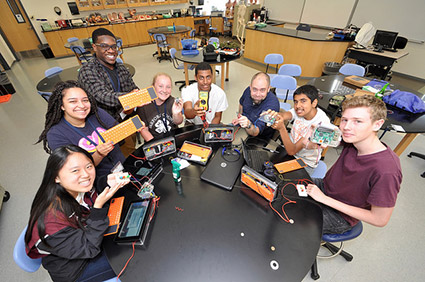 The Raspberry Pi is a small, barebones computer developed by The Raspberry Pi Foundation, a UK charity, with the intention of providing low-cost computers and free software to students. Raspberry Pi is used to do physical computing. Students will build a working Raspberry Pi computer. They will learn to program and interact with electronics they design. Students will focus on General Purpose Input and Output Math Modeling and Hazard Prediction and Assessment Capability (HPAC) to conduct a variety of projects which the students will design and implement.
The Raspberry Pi is a small, barebones computer developed by The Raspberry Pi Foundation, a UK charity, with the intention of providing low-cost computers and free software to students. Raspberry Pi is used to do physical computing. Students will build a working Raspberry Pi computer. They will learn to program and interact with electronics they design. Students will focus on General Purpose Input and Output Math Modeling and Hazard Prediction and Assessment Capability (HPAC) to conduct a variety of projects which the students will design and implement.
Motorized Droplet Actuation System (Exploring Engineering through Hopping the Droplets)
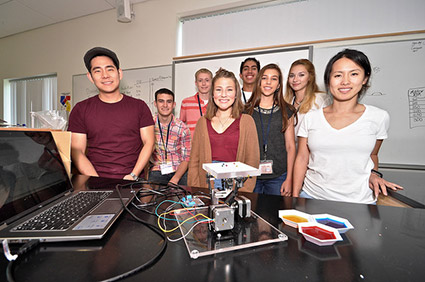 A motorized droplet actuation system manipulates droplets on a superhydrophobic surface (created on plastic sheets) by gravitational forces and mechanical agitation. The superhydrophobic plastic sheets are further printed with unique symbols using a hydrophilic ink. A microcontroller controls the direction and timing of two stepper motors which, in turn, provide mechanical agitation for droplet transport. Droplets remain confined to the hydrophilic symbols, and are able to ‘hop’ to neighboring symbols by gravity when the surface is agitated and tilted to a certain degree. A graphical user interface (GUI) software is developed in Matlab to remotely access and control the mechanical movement of the droplet actuation system. Using this basic principle, the following droplet operations can be performed: transport of single and multiple droplets, transport of larger-volume droplets, merging and mixing of multiple droplets, dispensing of fixed-volume droplets from a large droplet or liquid reservoir, and one-directional movement of droplets.
A motorized droplet actuation system manipulates droplets on a superhydrophobic surface (created on plastic sheets) by gravitational forces and mechanical agitation. The superhydrophobic plastic sheets are further printed with unique symbols using a hydrophilic ink. A microcontroller controls the direction and timing of two stepper motors which, in turn, provide mechanical agitation for droplet transport. Droplets remain confined to the hydrophilic symbols, and are able to ‘hop’ to neighboring symbols by gravity when the surface is agitated and tilted to a certain degree. A graphical user interface (GUI) software is developed in Matlab to remotely access and control the mechanical movement of the droplet actuation system. Using this basic principle, the following droplet operations can be performed: transport of single and multiple droplets, transport of larger-volume droplets, merging and mixing of multiple droplets, dispensing of fixed-volume droplets from a large droplet or liquid reservoir, and one-directional movement of droplets.
3D Printing
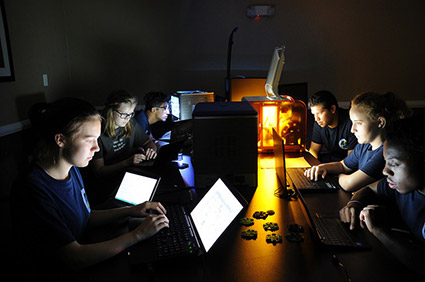 The project will be two fold. Students and teachers will partner with Army Research Laboratory (ARL) staff to actually build 3D printers. Then they will use the printers to fabricate a device with a living hinge. A living hinge is a flexible area of a larger rigid component that is made of the same material. This can be accomplished by thinning of a section in some cases, but with the capabilities of 3D printing, this can be accomplished by “creative geometry.” (see “living hinge” in Google images).
The project will be two fold. Students and teachers will partner with Army Research Laboratory (ARL) staff to actually build 3D printers. Then they will use the printers to fabricate a device with a living hinge. A living hinge is a flexible area of a larger rigid component that is made of the same material. This can be accomplished by thinning of a section in some cases, but with the capabilities of 3D printing, this can be accomplished by “creative geometry.” (see “living hinge” in Google images).
Plugging into the Internet of Things
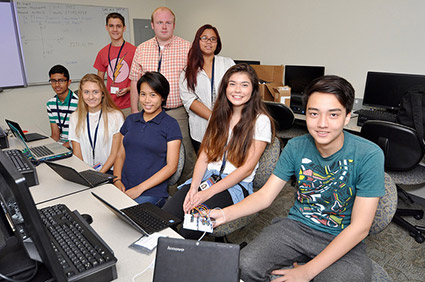 This group is a hands-on exploration of the future of technology in which the majority of electronic devices are connected to the internet. Students will learn the basics of electronics, physical computing, and software development in order to develop devices that can communicate with and be controlled through the web. The group will also engage in a discussion of the potential risks the internet of things may pose in the future and ways in which society may feel the impact. Students will build a robot that can be talked to through the internet of things.
This group is a hands-on exploration of the future of technology in which the majority of electronic devices are connected to the internet. Students will learn the basics of electronics, physical computing, and software development in order to develop devices that can communicate with and be controlled through the web. The group will also engage in a discussion of the potential risks the internet of things may pose in the future and ways in which society may feel the impact. Students will build a robot that can be talked to through the internet of things.
Middle School Student Projects
The Technology and Engineering of Drones
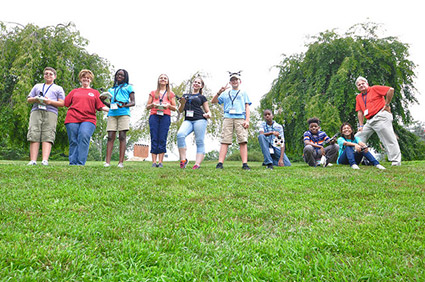 Students will research the evolution of drones, challenges in production, aerodynamic considerations, and safety. Additional focus will be on past, current, and future uses. They will be asked to come up with a specific application that interests them (perhaps specific to their hometown) and report on how it could be implemented. Field trips will include a visit to The Smithsonian Air and Space Museum as well as the campus of the University of Maryland - College Park. They will also have the opportunity to pilot their own drones.
Students will research the evolution of drones, challenges in production, aerodynamic considerations, and safety. Additional focus will be on past, current, and future uses. They will be asked to come up with a specific application that interests them (perhaps specific to their hometown) and report on how it could be implemented. Field trips will include a visit to The Smithsonian Air and Space Museum as well as the campus of the University of Maryland - College Park. They will also have the opportunity to pilot their own drones.
Qualitative Analysis
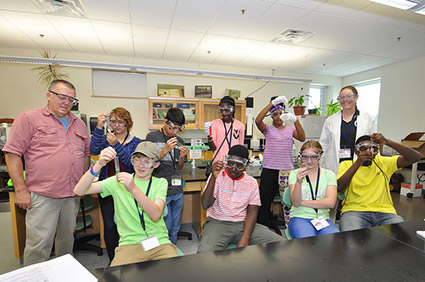 In qualitative analysis one determines what substances are present in a given material. Spectral analysis furnishes the best general system for detection of substance. However, the necessary instruments for applying the principles of spectral analysis throughout the complete useful portion of the spectrum are quite expensive and frequently complicated. In this course, we will limit the application of spectral analysis to the visible portion of the spectrum. Using known properties of solubility, students will analyze unknowns and determine the presence or absence of particular ions. Students will learn to use an array of laboratory equipment, techniques, and observation skills.
In qualitative analysis one determines what substances are present in a given material. Spectral analysis furnishes the best general system for detection of substance. However, the necessary instruments for applying the principles of spectral analysis throughout the complete useful portion of the spectrum are quite expensive and frequently complicated. In this course, we will limit the application of spectral analysis to the visible portion of the spectrum. Using known properties of solubility, students will analyze unknowns and determine the presence or absence of particular ions. Students will learn to use an array of laboratory equipment, techniques, and observation skills.
3D Printing
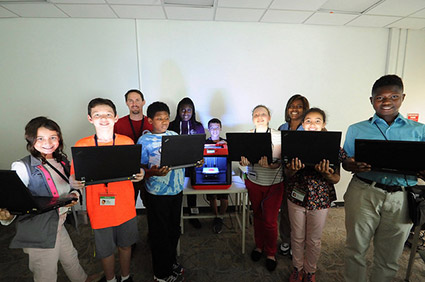 3D printing is an additive manufacturing process whereby objects are built up from plastic filament, liquid resin, layers of powder, or even bio-compatible and edible materials. Desktop 3D printing is today’s printing press, putting rapid prototyping, customizable products, and individualized medical appliances in reach of the general public. Literacy in basic 3D modeling and manufacturing is an essential skill for future STEM success in this country. In this course students will learn how to be “makers” by using various types of 3D modeling software, printing actual physical objects that they have designed and modeled themselves, and participating in educational outreach in the university and the community.
3D printing is an additive manufacturing process whereby objects are built up from plastic filament, liquid resin, layers of powder, or even bio-compatible and edible materials. Desktop 3D printing is today’s printing press, putting rapid prototyping, customizable products, and individualized medical appliances in reach of the general public. Literacy in basic 3D modeling and manufacturing is an essential skill for future STEM success in this country. In this course students will learn how to be “makers” by using various types of 3D modeling software, printing actual physical objects that they have designed and modeled themselves, and participating in educational outreach in the university and the community.
Teacher Projects
- Mining the Aerobiome for Novel Antimicrobial Compounds
- Solar Degradation of Organisms (Influence of Irradiation at Multiple Wavelengths)
- In Vitro Characterization of Drug-Drug Interaction and Cardiotoxicity
- 3D Printing
- Military Packaging
Mining the Aerobiome for Novel Antimicrobial Compounds
The need for new antibiotic classes and drug scaffolds is critical as resistance to available antibiotics continues to rise, and few, if any, new antibiotic classes have been introduced within the last 10 years. Approximately two-thirds of all known antibiotics are produced by Actinomycetes, making these organisms an important player in the fight against emerging multidrug-resistant pathogens. The extreme environmental conditions of the lower atmosphere provide an easily-accessible reservoir of these novel bacteria as the relatively inhospitable conditions of this environment enrich for rare Actinomycetes over the more abundant, but less tolerant, microbes found in the soil. This project is directed at the development of an antimicrobial discovery pipeline that queries bacteria found in atmospheric aerosols for novel antibiotic biosynthesis pathways with the potential to produce new drug moieties and scaffolds. Compounds discovered as a result of this effort will be correlated with a geographical location, altitude and underlying terrestrial biome, and be used to enrich the repertoire of potential new antibiotic scaffolds while delivering concrete new understanding of the nature and composition of the aerobiome.
Solar Degradation of Organisms (Influence of Irradiation at Multiple Wavelengths)
A critical component to understanding the fate of biological warfare agents is the degradation of these compounds by UV light. Due to the influence of ozone in the atmosphere, much of the energetic wavelengths of UV light are filtered out, leaving the UV-B and UV-A bands. While the UV-B band possesses germicidal properties by damaging the DNA within organisms, longer wavelengths in the UV-A and visible wavelengths are thought to aid DNA repair mechanisms. To truly understand the degradation of organisms under solar irradiation, measurements should be performed that capture the interplay of damage and repair mechanisms. For the JSTI Summer Program, the participant will work with measurements of the degradation of simulants, Biosafety level 1 organisms (organisms not known to cause pathogenesis in humans, egg whites also fall into this category) under exposure to simulated solar light. Light is generated from a solar simulator that consists of a high power Xenon lamp that is filtered to mimic the wavelengths of sunlight that reach the earth’s surface. These results will be compared to measurements performed with individual UV wavelengths to assess the effect of DNA repair mechanisms aided by longer wavelength light. It is expected the participant will gain experience in 1) environmental chemistry, 2) some basic aerosol science, and 3) microbiology.
In Vitro Characterization of Drug-Drug Interaction and Cardiotoxicity
The USAMRICD Absorption, Distribution, Metabolism, Excretion, and Toxicity (ADMET) Center has established in vitro procedures to evaluate liver metabolism and drug-drug interaction as part of the Tier 1 ADMET profiling. Liver microsomes contain the main enzymes for drug metabolism, the cytochrome P450 enzyme (CYP450) family. Microsomal stability is used to measure the intrinsic clearance rate, which can impact toxicity and dosing considerations. The drug-drug interaction assay measures the half-maximal inhibitory concentration (IC50) using fluorescent substrates and standard inhibitors for each FDA-recommended P450 enzyme. High-throughput (HTP) methods for assessing microsomal stability and drug-drug interaction using a Biomek FxP liquid handling platform has been established for use in these two assays. This provides multiple advantages, such as more data collection in less time, fewer errors associated with manual pipetting, and increased accuracy for quenching reactions at precise time points. Similarly to P450 inhibition, P450 enzyme induction can disrupt drug pharmacokinetics. Human hepatocytes are the gold standard for CYP induction; however, they have inherent limitations such as large lot-to-lot variability, high cost and limited lot sizes. Current validation studies, using immortalized hepatic cells lines, are being conducted to determine which cell lines best model CYP induction as compared to human hepatocytes. Currently, we demonstrate CYP induction for CYP3A4 and CYP1A2 in the HepaRG cell line. Other hepatic cell lines will be tested and compared. Regarding early evaluation of potential cardiotoxicity, drug-induced heart dysrhythmias have been associated with blockage of the human ether-a-go-go related gene (hERG) channel. Patch clamp is the current gold-standard cardiotoxicity assessment method; however, it is expensive and time-consuming. An HTP method to assess hERG channel binding by fluorescence polarization is being validated for addition to the ADMET assay panel.
3D Printing
The JSTI project will be two fold. Teachers will partner with Army Research Laboratory (ARL) staff to build 3D printers. Then they will use the printers to fabricate a device with a living hinge. A living hinge is a flexible area of a larger rigid component that is made of the same material. This can be accomplished by thinning of a section in some cases, but with the capabilities of 3D printing, this can be accomplished by “creative geometry.” (see “living hinge” in google images) Teachers will explore classroom project ideas and direct examples for integration into their curricula.
Military Packaging
Teachers will explore the mathematics, geometry, and physics of military packaging and the importance of developing good packaging design. They will be exposed to some packaging materials, design concepts, packaging requirements and the environmental factors during transit, handling and storage. They will also be complete hands-on activities including developing and designing a package for an item that they are given and watching their design go through testing to determine pass or fail. Some things or requirements may tweak but basically the intent is for teachers to be creative and innovative in developing some designs and to be able to take the science and methodology back to their classrooms to integrate into their curricula.



